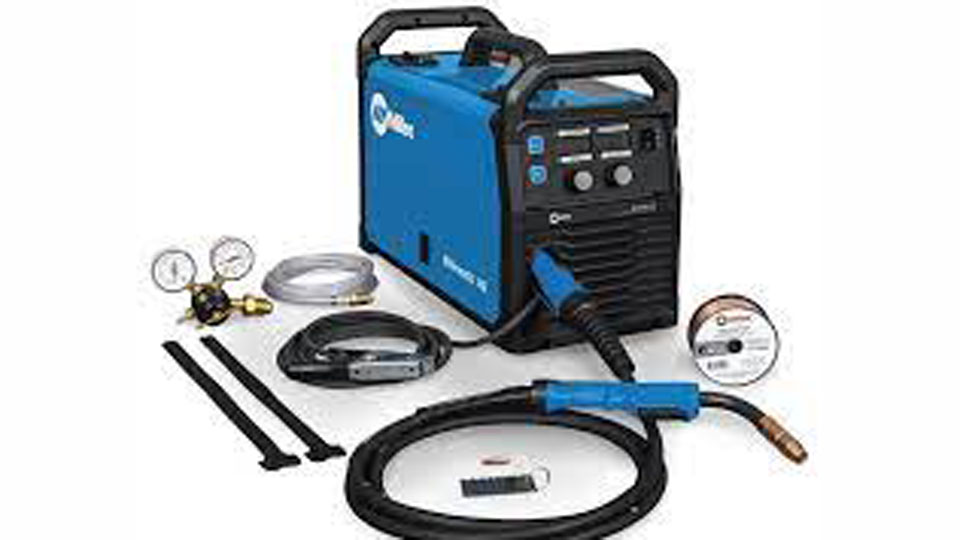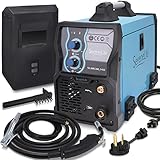When I first got into welding, I heard the term “inverter MIG welder” tossed around a lot. At first, I wasn’t quite sure what made it different from the regular welders I saw in workshops or job sites. Once I started using one myself, I realized why so many professionals and hobbyists prefer this kind of welder.
If you’ve been thinking about upgrading your welding machine or are just curious about what this tool actually is, I’m here to walk you through it like we’re sitting side-by-side in a workshop.

Photo by kmstools
Let’s break it all down in simple words so that anyone—from a complete beginner to a seasoned welder—can understand exactly what an inverter MIG welder is, how it works, why it’s useful, and whether it’s the right choice for you.
Understanding the Basics
At its core, an inverter MIG welder is a type of MIG (Metal Inert Gas) welder that uses modern electronics—specifically an inverter power supply—instead of traditional transformers.
This shift in technology gives the welder a huge advantage in terms of size, efficiency, control, and power delivery.
In simpler words, think of an inverter MIG welder as the smarter, lighter, and more flexible cousin of the old-school welders.
It still performs MIG welding—feeding a wire electrode through a gun while shielding the weld with gas—but it does it with much more efficiency and control.
When I first used one, the most immediate difference I noticed was how lightweight it was. I could carry it around my garage easily, unlike my older transformer unit that needed two people and a cart.
How Does an Inverter MIG Welder Work?
This part might sound a little technical, but I’ll keep it as friendly as possible. Traditional welders take the power from your wall outlet and convert it directly into the kind of current needed for welding. But that process can be slow and waste a lot of energy.
Inverter technology works differently. It first changes the AC power into DC, then rapidly switches it at a high frequency (like 20,000 to 100,000 times per second), and then converts it back into a smoother, more stable welding current.
This high-speed switching allows the welder to deliver more precise control over the arc and heat. You’ll notice your welds are cleaner, smoother, and easier to control—especially on thin metals. That’s why I love using it for automotive repairs or DIY home welding.
Benefits of an Inverter MIG Welder
Let me tell you, once you try an inverter MIG welder, it’s hard to go back. Here are the benefits I experienced firsthand:
Lightweight and Portable
I used to dread moving my old welder. It was bulky and heavy. With my inverter MIG welder, I can pick it up with one hand. This is perfect if you’re working in different spots in your garage or even taking it to a job site.
Energy Efficient
My power bills used to spike whenever I had a big welding project. Not anymore. Inverter machines use less electricity and still deliver strong welding power. You’ll notice you’re getting more work done with less power consumption.
Smooth Arc Performance
This was a game-changer for me. The arc starts instantly, stays consistent, and is much easier to manage. You don’t get those annoying arc pops or splatter like with older machines.
Better Control Over Settings
With digital controls and fine-tuning features, I can dial in the exact voltage, wire speed, and amperage I need. This means better welds and fewer mistakes—especially when working on delicate jobs.
Welds a Variety of Metals
My inverter MIG welder handles everything from mild steel to stainless, and even aluminum (with a spool gun). It’s great having a single machine that can do it all.
Inverter MIG Welder vs Traditional MIG Welder
Let’s put this into a simple comparison so it’s easy to see the difference:
| Feature | Inverter MIG Welder | Traditional MIG Welder |
|---|---|---|
| Weight | Lightweight (10–40 lbs) | Heavy (up to 100 lbs) |
| Portability | Easy to carry | Hard to move |
| Efficiency | Very efficient | Less efficient |
| Arc Stability | High frequency, smooth arc | Sometimes unstable |
| Cost | Higher upfront, but worth it | Lower cost, older tech |
| Power Usage | Lower power consumption | Higher power usage |
| Controls | Advanced digital settings | Basic manual controls |
In my opinion, if you’re looking to weld often and want quality results, the inverter is the better option—even if it costs a bit more upfront.
Where Can You Use an Inverter MIG Welder?
One of the best things about this type of welder is how versatile it is. I’ve used mine in all sorts of places and situations. Here are just a few:
- Garage or home workshops – Ideal for DIY projects, auto repair, and metal art
- On job sites – Light enough to move around easily
- Small fabrication shops – Perfect for welding steel frames, gates, and other structures
- Farm or ranch repairs – Whether fixing gates or equipment, it’s very handy
- Auto body work – Provides the fine control you need for thin panels and aluminum
If you’re working on a car project, building a fence, or making a sculpture, this machine has the flexibility you need.
What to Look for When Buying an Inverter MIG Welder
There are a lot of models out there, and not all inverter MIG welders are the same. When I bought mine, these were the things I considered:
Input Voltage
Check if the machine runs on 110V, 220V, or both. Dual-voltage machines are great because they work anywhere.
Amperage Range
Make sure it offers enough power for the type of welding you plan to do. If you’re only working with thin metal, lower amperage is fine.
Duty Cycle
This is how long the welder can run before it needs to cool down. Look for a high duty cycle if you plan to weld for long periods.
Wire Feed Speed Control
A good wire feed system is crucial. It needs to be smooth and adjustable.
Digital Display and Controls
A machine with clear digital readouts helps you make precise adjustments, which makes your welding cleaner and easier.
Spool Gun Compatibility
If you want to weld aluminum, make sure your machine supports a spool gun. Trust me, it makes the job way easier.
Size and Weight
Portability matters more than you think. Choose a machine that you can carry or roll around without needing a second person.
Common Brands and Price Range in the USA
If you’re shopping in the U.S., there are a few brands I’ve personally tested or heard great things about from fellow welders. Here’s a quick breakdown:
| Brand | Price Range (USD) | Notable Feature |
|---|---|---|
| Lincoln Electric | $500 – $2000 | Durable, pro-grade |
| Miller | $700 – $2500 | Excellent arc quality |
| Hobart | $500 – $1300 | Great for beginners |
| YesWelder | $250 – $900 | Budget-friendly, versatile |
| Everlast | $500 – $1500 | Advanced features for price |
I personally started with a Hobart model, and it was fantastic for learning. Later, I moved to a Lincoln because I needed more durability for everyday use.
Maintenance Tips to Keep Your Inverter MIG Welder Running Smooth
Taking care of your welder helps it last longer and perform better. Here’s how I maintain mine:
- Clean the wire feed regularly – Dust and metal shavings can clog it up.
- Check the connections – Make sure your cables are tight and the ground clamp is clean.
- Blow out the vents – Use compressed air to remove dust buildup from the cooling vents.
- Use proper storage – Keep the machine in a dry, clean place.
- Inspect the torch and nozzle – Replace any worn parts before they cause problems.
A little maintenance can go a long way. I check my machine after every few projects, and it’s never let me down.
Why I Recommend Inverter MIG Welders for Most Welders Today
If you’re just getting started or even if you’ve been welding for years, I truly believe an inverter MIG welder is a great investment. It’s the kind of machine that grows with you.
If you’re learning the basics or tackling complex metalwork, it has the features and flexibility to match your pace.
And as someone who’s had the chance to weld with both old transformer machines and newer inverter models, the difference is night and day. You feel more in control, your welds look better, and your time and energy are used more efficiently.
If you’re on the fence about making the switch, I say go for it. You won’t regret the upgrade.
Conclusion
So, what is an inverter MIG welder? It’s a smarter, more advanced, and user-friendly version of a traditional MIG welder.
If you’re working from your garage, doing auto repairs, or fabricating steel for your next project, this tool gives you the control, efficiency, and reliability you need.
It’s lightweight, easy to use, and delivers a clean, stable arc that can make even a beginner’s weld look good. I’ve come to appreciate how versatile and dependable this machine really is.
If you’re looking for a welder that can handle a wide range of tasks without breaking your back or your budget, I’d definitely recommend looking into an inverter MIG welder.
It’s a choice that will keep you welding smoothly for years to come.
FAQs
What is the main difference between an inverter MIG welder and a regular MIG welder?
An inverter MIG welder uses modern electronics to provide more stable arc performance, better energy efficiency, and lighter weight compared to traditional welders that use heavy transformers.
Can I use an inverter MIG welder to weld aluminum?
Yes, you can weld aluminum with an inverter MIG welder, especially if it supports a spool gun. This makes feeding softer aluminum wire much easier.
Are inverter MIG welders good for beginners?
Absolutely. They’re user-friendly, offer better arc control, and come with digital settings that help beginners make clean welds right from the start.
Do inverter MIG welders consume less power?
Yes, they’re designed to be energy-efficient. This means lower electricity costs and less heat wasted during welding.
Is an inverter MIG welder worth the extra cost?
In my experience, yes. While they may cost more upfront, the performance, efficiency, and portability make them a better long-term investment.
Can I use an inverter MIG welder outdoors?
You can, but make sure to use the proper shielding gas and protect the weld area from wind to avoid contamination.
How long do inverter MIG welders last?
With proper maintenance, they can last many years. Keeping it clean and checking for wear on parts will ensure you get the most life out of your welder.

![ARCCAPTAIN 135A MIG Welder, 2025 Newest [Large LED Display] 110V Welder Flux Core MIG, Lift TIG, Stick, 3 in 1 Welding Machine Gasless MIG Welder Machine 110V, IGBT Inverter Welder with Synergy, 2T/4T](https://m.media-amazon.com/images/I/51DpCeYALzL._SL160_.jpg)


